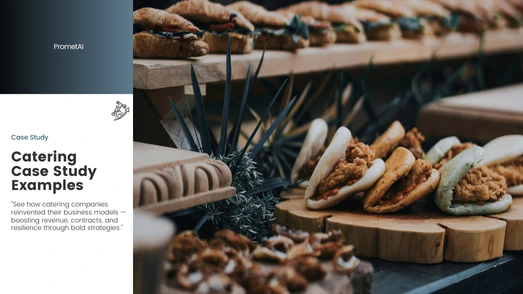Explore catering case studies in corporate, wedding, and sustainable catering—how hybrid, luxury, and zero-waste strategies grow contracts, revenue.
Case Study 1: How GourmetEdge Catering Increased Corporate Contracts by 65% with a Hybrid Model
GourmetEdge Catering has been part of San Francisco’s food scene since 2014, offering a wide range of catering services that blend flavor with professionalism. From event catering and corporate catering to office catering and boxed lunch catering, the company serves as a trusted catering company for both private and business needs. With the ability to prepare more than 1,200 meals per day, GourmetEdge has positioned itself as a flexible meal delivery service and reliable B2B food service provider that can scale to any occasion.
About the Business
Name: GourmetEdge Catering
Location: San Francisco, California, USA
Type: Mid-sized catering company (corporate and private events)
Founded: 2014
Capacity: 1,200+ meals/day
By 2019, success came with cracks beneath the surface. GourmetEdge had built a name in the local event space, but the business faced several catering business challenges that threatened to stall its growth.
The first issue was catering seasonality. Weddings and banquets filled the calendar during the summer and December holidays, but in spring and fall demand slumped. Revenue rose and fell sharply, creating uncertainty in planning.
The second challenge was structural. An overreliance on private events left the business vulnerable. These bookings required complex event logistics, scaling staff, coordinating venues, and absorbing high delivery costs. At the same time, growing catering competition from lower-cost providers squeezed already thin profit margins in catering.
Behind the scenes, staffing challenges in catering created further instability. The need to assemble large teams on short notice drained resources and hurt consistency. Without a new growth strategy, GourmetEdge risked becoming just another name in an overcrowded market.
In 2020, GourmetEdge decided to transform its business with a hybrid model that combined traditional event catering with corporate lunch subscriptions, office lunch delivery, and boxed lunch delivery. The new model also leaned heavily on technology and digital transformation to improve efficiency and scale.
Corporate Subscriptions
To tap into steady B2B demand, the company introduced a “Weekly Lunch Program” with fixed pricing per employee. Multiple tiers (standard, premium, and vegan) gave flexibility. This move generated consistent subscription meals, driving predictable B2B sales growth and creating long-term client relationships.
Meal Boxes (B2B & B2C)
GourmetEdge launched individually packaged lunch boxes, meeting demand from both offices and remote workers during COVID-19. Through channel partnerships with delivery platforms, the company reached corporate clients as well as direct consumers, strengthening its meal delivery service footprint.
Technology & Automation
An online ordering system gave companies the ability to schedule recurring meals for weeks at a time. At the same time, kitchen management software streamlined procurement, cut waste, and improved operational efficiency, allowing GourmetEdge to scale without overextending resources.
Marketing & Positioning
To boost customer acquisition and lead generation, GourmetEdge ran targeted LinkedIn marketing campaigns to reach HR managers and office administrators, while Instagram ads promoted its “Healthy & Local” positioning. This premium image supported stronger pricing power and improved marketing ROI by focusing on decision-makers rather than broad audiences.
The Results (After 12 Months)
The shift to a hybrid model reshaped the company’s financial profile. In just one year, corporate contracts rose from 28 to 46, a 65% increase that fueled long-term stability. This growth established a foundation of recurring B2B sales growth and added a reliable stream of monthly recurring revenue (MRR) worth $185,000.
Other catering KPIs showed similar improvement. Seasonal revenue dips, once as steep as 42%, narrowed to 12%. The average order value (AOV) grew from $1,200 to $2,050, a 71% increase driven by corporate packages and subscription meals. Just as importantly, customer retention improved as once-occasional clients signed long-term contracts.
Performance snapshot
Metric | Before (2019) | After (2020) | Change |
Corporate Contracts | 28 | 46 | +65% |
Monthly Recurring Revenue (MRR) | $0 | $185,000 | New Stream |
Seasonal Revenue Drop | –42% | –12% | Stabilized |
Average Order Size | $1,200 | $2,050 | +71% |
Development Path
From 2014 to 2018, GourmetEdge built its reputation as a traditional catering company, specializing in event catering such as weddings, galas, and banquets. But by 2019, growth slowed as catering competition and staffing challenges in catering began eroding margins.
The 2020 business model pivot into subscription revenue, corporate catering, and boxed lunch delivery marked a turning point. With channel partnerships, improved operational efficiency, and stronger B2B sales growth, GourmetEdge built a recurring revenue model that stabilized the business. By 2021, GourmetEdge had stabilized revenue and was positioned for sustainable expansion.
GourmetEdge’s success demonstrates how catering growth strategies can thrive when supported by innovation and adaptability. By combining events, subscriptions, and boxed meals, the company built resilience against seasonality and competitive pricing pressures.
A recurring revenue model through subscriptions delivers stability in industries prone to fluctuation.
Digital transformation from online ordering systems to kitchen automation aboosts scale and efficiency.
Smart customer acquisition and lead generation via LinkedIn and Instagram improved marketing ROI by targeting decision-makers.
A strong premium positioning (“Healthy & Local”) allowed GourmetEdge to charge higher prices while increasing customer retention.
GourmetEdge Catering showed that success in the food industry doesn’t come from chasing volume, but from designing a hybrid model that balances B2B food service, recurring contracts, and premium branding.

 EleganceCaterers proves that stepping out of the mid-market and into luxury requires more than raising prices; it requires redefining the experience.
EleganceCaterers proves that stepping out of the mid-market and into luxury requires more than raising prices; it requires redefining the experience.